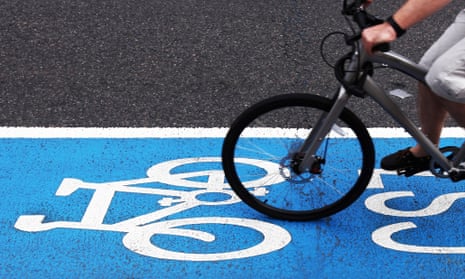A former senior member of Kingston Council has complained that designs for the first phase of the borough’s “mini-Holland” cycling scheme show something “very different” from the plans that secured around £30m of Transport for London (TfL) money last March.
Simon James, a Lib Dem and keen cyclist who lost his seat at last May’s election when his party lost control to the Conservatives, has told local media that he had intended “100% segregation for cyclists” but that new illustrations show physically separated cycle lanes along only about a quarter of the stretch of Portsmouth Road concerned.
James wasn’t the first to feel let down. In January, the co-ordinator of the Kingston Cycling Campaign had expressed dismay that the pictures showed “just a white line” between cyclists and other road traffic instead of a physical barrier. “Our main concern is there is not enough protective space for cyclists,” he said. “Cyclists want complete segregation to feel safe.”
The response from the council has been interesting. Councillor Richard Hudson claimed, perhaps incongruously, that the project is “to benefit pedestrians and motorists as well as cyclists” and accused cycling campaigners of trying to “take over” the whole thing. More interesting still, though, are the remarks of Richard Lewis, the Kingston transport planner managing it.
He told reporter Rachael Burford that, in his opinion, “a lot of cycling schemes have been over-engineered.” Lewis mentioned studies indicating that cyclists were passed more slowly by cars if the line in the middle of he road was removed, seemingly making the point that road-management measures other than segregated lanes can be effective in improving cyclists’ safety.
However, stressing that the project was then still at the consultation stage, Lewis said: “At the moment, what we are hearing is that people want more segregation.” And he added: “We are also at the mercy of TfL, and [the mayor’s cycling adviser] Andrew Gilligan always wants more segregation for cyclists. They are providing the money and if they say jump we will jump.”
Lewis’s comments got my attention because even mild challenges to the view that segregated lanes are the best way to improve cyclists’ safety have been close to non-existent in what’s passed for a debate about Boris Johnson’s cycling infrastructure programme. Though claiming no deep knowledge of the matter I am aware that disputes between segregationists and integrationists have long had the character of a War Without End. Yet in the recent London context the consensus in favour of the former has been almost literally stifling.
Cycling campaigners across the metropolis seem united in hailing segregated lanes as a New Dawn. Rather than interrogate the rationale behind them, London Assembly politicians have competed with each other to echo this adulation and align themselves with melodramatic claims that Evil Bankers and “the rich” have been plotting to destroy the entire thing. There have been and remain objections to aspects of the flagship “superhighways” from significant, legitimately interested parties, but nothing fundamental. I doubt if any high profile mayoral transport policy has ever been more certain of delivery. Apart from anything else, Johnson’s juggernaut ego demands it. Everything else had better get out of its way.
So, might Richard Lewis have a point? To widen the question, is the segregation element of the mayor’s vision for cycling - which has a number of dimensions, of course - the best use of resources for increasing the safety of cyclists? I recognise that even to ask such a question will be seized on by some as evidence of closet cycling-hatred or else as outrageous heresy, provoking enraged online pursuit by witchfinders on two wheels.
But, of course, not all cyclists are one-eyed. For them, and other thoughtful readers, here is an excerpt from a summary of research into cycling infrastructure from the Road Safety Observatory, a body run by representatives of various transport organisations including the Department for Transport and the Royal Society for the Prevention of Accidents.
It is often possible to improve “perceived” road safety significantly by providing cycling infrastructure, but it is more difficult to prove that cycling infrastructure has reduced casualty numbers...The hierarchy of measures approach suggests that traffic reduction, speed reduction and junction treatment should be considered before redistribution of the carriageway (installing cycle lanes)...The research has highlighted the advantages and disadvantages of each type of cycling infrastructure. In a limited number of cases there has been a significant positive effect on road safety, but in general it is only “perceived” safety that improves.
I know that well-informed cyclists, including friends of mine in the London Assembly’s Green Party camp, take issue with the Observatory’s approach. Maybe you do to. Maybe you don’t. Either way...discuss.





Comments (…)
Sign in or create your Guardian account to join the discussion